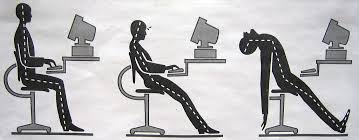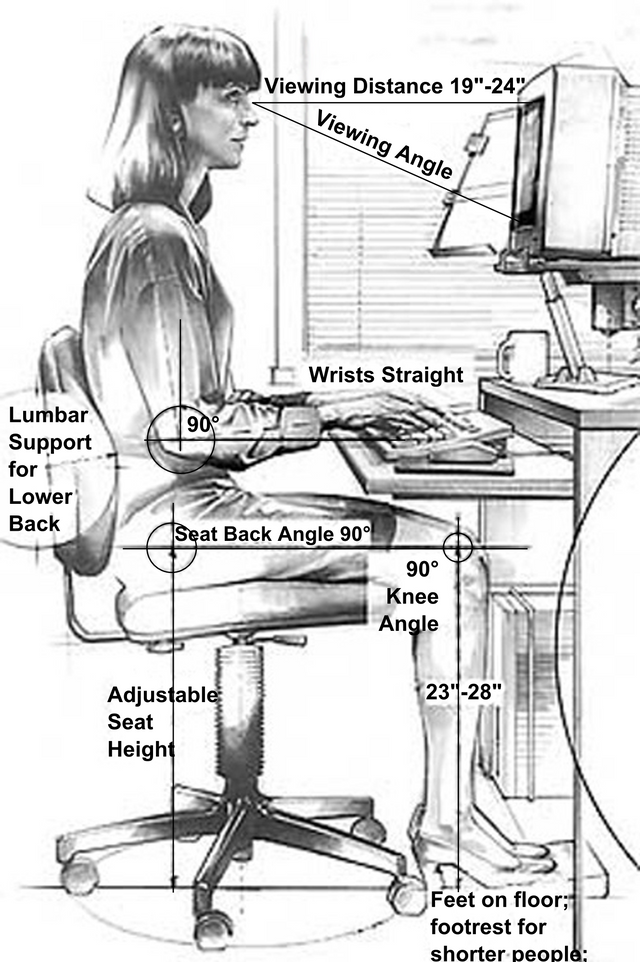ERGONOMICS; THE SCIENCE OF COMFORT
Once in a while after a long day at work, one might feel this pinching pain in the spine or a constant ache in the shoulder. Although after enough rest and probably a massage (wink) the pain goes away but… have you tried to consider why the pain comes back after a few days?
You might be bold to say; “I don’t go through stress at work” “why then should I always have a back ache?” but have we tried to consider the situations surrounding the * persistent or occasional aches? * If not, here is a post that would discuss something related to the issue.
.jpg)
source
I am neither a neurologist nor an orthopedic practitioner, this post is coming from an engineer’s perspective
In this post, I would be discussing the topic ERGONOMICS and how it is important to ensure a pain or accident free lifestyle.
On my first encounter with the word ergonomics I thought it to be one with complex meanings. I never envisaged it to be relating to something such as daily activities or human routine.
According to Merriam Webster dictionary, a science that deals with designing and arranging things so that people can use them easily and safely.
In other words, ergonomics is a practice that involves the design or specific arrangement of a place (workplace, home or offices), products and systems in a manner that they will fit the people that use them. Also referred to as human factors and ergonomics, comfort design, functional design and systems, it involves the design of these products and systems taking into account the interaction between the users and the products.
To some people, ergonomics deals only with cases such as sitting posture or controls of instruments such as cars and machines. Of course that is right but ergonomics covers even more than that. It actually relates to designing of anything that involves human interaction.
Just as defined by the international ergonomics association,
Ergonomics relates to a lot of other disciplines such as psycology, industrial design, physiology, biomechanics, anthropometry and ultimately, engineering as it involves the study and designing of equipments, devices and process *that fit the human body.
One might start to wonder; how does ergonomics relate to me? Here is an answer from my desk; in a lot of ways it does!
Well, according to a study, lower back pain is said to be the world’s most common work related disability affecting a wide range of vocations. This high percentage of similar work related issue sis due to the absence or improper application of ergonomics.
As stated earlier, ergonomics if properly applied helps to keep you safe, increase your comfortability and aid your productivity in your workplace by relating your abilities to the design of the layout of the equipment to be used or the setup of the work area. Properties such as body size, strength, speed or skill, reflex or sensory abilities and attitudes or reactions.
Extending the point of interest outside the area of work, public facilities such as transport facilities, (trains, buses, airplanes), public utility (public toilet, parks) and other related facilities, ergonomics is applied to ascertain that the needs of the populace is accommodated.
The right ergonomic design is important in order to prevent repeated strain injuries and other musculoskeletal disorders which if not checked, might lead to long term disability.
From my desk, the answer is YES. Ergonomics can be termed as a science as it is involved with the study of human behavior (– psychology) in order to apply the results in designing (– engineering) the equipment to be used so as to ensure comfort (–human kinetics) and optimum performance.
Ergonomics is usually employed to accomplish the goals concerning occupational health and safety.and concerned with the “agreement” between equipment and user while taking into account the properties pf the user.
According to the International Ergonomics Association, there are three main domains of specialization within ergonomics
- PHYSICAL ERGONOMICS:
This is the most common aspect of ergonomics. All the knowledge a lot of people have
about ergonomics is only on physical ergonomics.
Physical ergonomics deal with human anatomy, anthropometric, physiological and bio mechanical characteristics in relation to physical activity. Consumer and industrial product design and the medical field are the areas where physical ergonomics are widely used with the medical application specific with those diagnosed with arthritis or carpal tunnel syndrome. Even in the case of those that are not suffering from the disorder, physical ergonomics is implemented to prevent such occurrences.
Speaking of work related injuries, the Work-related Musculoskeletal Disorder (WRMD) is the most prevalent and results in a series of side effects such as persistent pain,loss of functional capacity and work disability.
Physical ergonomics is therefore concerned with the * physical * conditions of the user in relation to the equipment.
when next you are going on a job, ensure the conditions are conforming with the priciples of physical ergonomics.
- COGNITIVE ERGONOMICS:
In contrast to physical counterpart, this aspect of ergonomics is related to the mental processes involved in the activity. Processes such as perception, reasoning, memory, response and how they affect the interactions among humans and the system in question.
Points of interest are; mental workload, reliability of performance, skill, work stress, decision making ability.
cognitive ergonomics are involved with how the working or operating conditions influence the mental performance of the user or operator.
- ORGANISATIONAL ERGONOMICS
In quick simple terms, organizational ergonomics deal with how the sociotechnical systems can be optimized to suit the user or operator. Cases such as communication, work design, teamwork, work times design, cooperative work, quality management, participatory design and a host of others.
As the word implies organizational ergonomics deal with how the conditions are set to suit the user or operator to prevent a hazard.
Basically, in order to achieve its objectives, ergonomics use the data gotten from several disciplines and the techniques adopted from others. Below are a list of disciplines that are depended upon by ergonomics:
- Biomechanics
- Environmental physics
- Psychology
- Anthropometry
Obviously, ergonomics is important and ultimately beneficial to all humans and
organizations that have the welfare of their employees at heart. Prevention of extreme or mild hazards that are related to the daily use or operation of machinery or just simply transit is optimum.
Below are a few benefits of ergonomics:
- It creates a better safety culture
- it improves the quality (of products or operations)
- it improves productivity
- It reduces cost
Now lets narrow the whole post down to workplace ergonomics or better still, steemit ergonomics, it would really save a lot of cash if ergonomics is efficiently applied to daily routine. Using steemit? Here are a few physical ergonomic tips;
- ensure a viewing distance of about 19 to 24 inches
- keep your wrists straight while using the keyboard
- keep the seat back angle at 90 degrees
- ensure a lumbar support for your lower back
- adjust the seat height corresponding to your height
- ensure a knee angle of 90 degrees
- ensure the feet is on the floor (shorter people can use footrest)
Ofcourse these tips are for people using a pc and a desk.
CONCLUSION
if you want to use an equipment, use it the right way.
Ergonomics is important in daily life to eliminate hazard in operation of machinery or simple lifestyle.
I don’t think there is need to say too much as I feel the above statement summarizes the point.
REFERENCES
ERGONOMICS | ERGONOMICS DEFINATION | HUMAN FACTORS AND ERGONOMICS | BENEFITS OF ERGONOMICS
